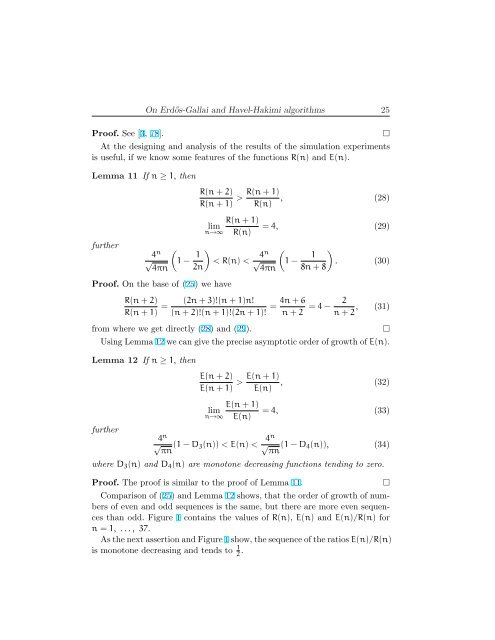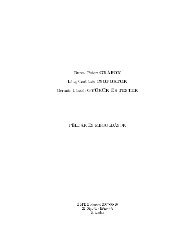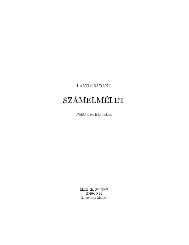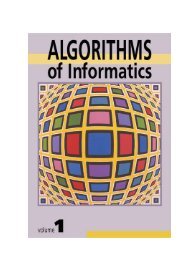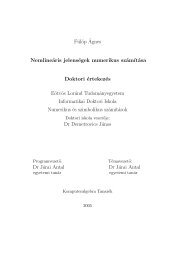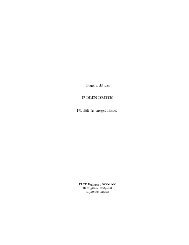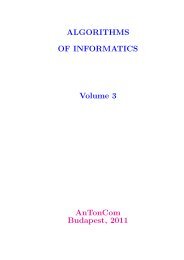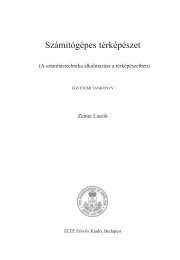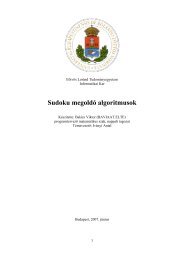On Erd˝os-Gallai and Havel-Hakimi algorithms
On Erd˝os-Gallai and Havel-Hakimi algorithms
On Erd˝os-Gallai and Havel-Hakimi algorithms
You also want an ePaper? Increase the reach of your titles
YUMPU automatically turns print PDFs into web optimized ePapers that Google loves.
<strong>On</strong> Erdős-<strong>Gallai</strong> <strong>and</strong> <strong>Havel</strong>-<strong>Hakimi</strong> <strong>algorithms</strong> 25<br />
Proof. See [3, 78]. <br />
At the designing <strong>and</strong> analysis of the results of the simulation experiments<br />
is useful, if we know some features of the functions R(n) <strong>and</strong> E(n).<br />
Lemma 11 If n ≥ 1, then<br />
further<br />
R(n + 2)<br />
R(n + 1)<br />
R(n + 1)<br />
> , (28)<br />
R(n)<br />
R(n + 1)<br />
lim = 4, (29)<br />
n→∞ R(n)<br />
4n <br />
√ 1 −<br />
4πn<br />
1<br />
<br />
< R(n) <<br />
2n<br />
4n<br />
<br />
1<br />
√ 1 − . (30)<br />
4πn 8n + 8<br />
Proof. <strong>On</strong> the base of (25) we have<br />
R(n + 2)<br />
R(n + 1) =<br />
(2n + 3)!(n + 1)n! 4n + 6 2<br />
= = 4 − , (31)<br />
(n + 2)!(n + 1)!(2n + 1)! n + 2 n + 2<br />
from where we get directly (28) <strong>and</strong> (29). <br />
Using Lemma 12 we can give the precise asymptotic order of growth of E(n).<br />
Lemma 12 If n ≥ 1, then<br />
further<br />
E(n + 2)<br />
E(n + 1)<br />
E(n + 1)<br />
> , (32)<br />
E(n)<br />
E(n + 1)<br />
lim = 4, (33)<br />
n→∞ E(n)<br />
4 n<br />
√ πn (1 − D3(n)) < E(n) < 4n<br />
√ πn (1 − D4(n)), (34)<br />
where D3(n) <strong>and</strong> D4(n) are monotone decreasing functions tending to zero.<br />
Proof. The proof is similar to the proof of Lemma 11. <br />
Comparison of (25) <strong>and</strong> Lemma 12 shows, that the order of growth of numbers<br />
of even <strong>and</strong> odd sequences is the same, but there are more even sequences<br />
than odd. Figure 1 contains the values of R(n), E(n) <strong>and</strong> E(n)/R(n) for<br />
n = 1, . . . , 37.<br />
As the next assertion <strong>and</strong> Figure 1 show, the sequence of the ratios E(n)/R(n)<br />
is monotone decreasing <strong>and</strong> tends to 1<br />
2 .


